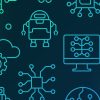In my previous column, I discussed the progress made by the UK technology sector in terms of sustainability in the last year. This included advancements in quantum computing, the synergy between datacentres, and the increase in businesses reducing and recycling their e-waste.
At Digital Catapult, we are constantly evaluating how emerging technologies and new solutions can help industries and sectors with high emissions achieve their net-zero goals. There has been significant progress in this area, and as we enter 2024, IT leaders should focus on managing their sustainability resolutions in several key areas like transforming datacentres, prioritizing environmental considerations, and leading the circular economy.
Since sustainability will be a top priority in the commercial landscape next year, it is crucial for business leaders to immediately address these areas of innovation. This will not only improve their companies’ credibility but also appeal to the growing number of environmentally conscious customers and partners.
New year, new datacentres:
In 2024, we anticipate a record number of datacentres transitioning to 100% renewable energy. Research has shown that traditional datacentres consumed 97.6 terawatt hours of energy in 2015, with expectations of a decrease to 33 terawatt hours by 2021. However, more research is needed to verify this trend. Regardless, the energy demand of datacentres is enormous and equivalent to that of a small-to-medium-sized country. Transitioning to renewable energy is crucial for businesses of all sizes as it significantly reduces both the carbon footprint of datacentres and the emissions of their customers.
IT leaders should engage with their cloud providers to understand their renewable energy roadmaps and ensure their data is stored in facilities powered by renewable sources. This will not only enhance their sustainability credentials but also play an instrumental role in driving business change and fostering the adoption of sustainable innovations. It is essential to establish the right digital infrastructure to support a net-zero transition, ensuring agility and avoiding unexpected financial pressures while facilitating incremental improvements over the next two decades.
Incorporating green decision-making:
By the end of next year, every IT leader should consider the carbon emissions associated with their data management and storage, encompassing both internal and external digital infrastructure. Understanding the environmental impact of infrastructure choices should drive decision-making regarding data management and partnerships. The upcoming year will witness significant innovation that enables companies to measure and reduce carbon emissions through cloud services, similar to tools optimizing infrastructure costs. Tools like Digital Catapult’s Ecometer tool can measure environmental impacts, baseline carbon intensity, and guide businesses in taking effective actions to mitigate environmental damage.
Leading the circular economy:
The topic of sustainable innovation, already a priority for many business leaders, deserves further attention. Proper management of electronics at the end of their lifecycle is essential. Supply chain programs focusing on end-of-life strategies, such as reusing, repairing, or remanufacturing products, enhance the traceability of electronics like laptops, phones, and server racks. This can involve returning them to manufacturers or donating them to schools and community groups.
One of our efforts in this area is the Digital Supply Chain Hub, a national program that integrates digital technology into UK supply chains. By fostering collaboration among stakeholders, including government, large enterprises, SME manufacturers, and industry leaders, the Hub aims to create a globally competitive, digitally innovative ecosystem. Our work within the Hub aims to make supply chains more efficient, resilient, and sustainable, addressing critical challenges in UK manufacturing. With the utilization of technologies like artificial intelligence (AI), distributed ledger technology (DLT), and the internet of things (IoT), the Hub will play a crucial role in contributing to the circular economy in the coming year.
As regulators, customers, and stakeholders increasingly demand progress in sustainability from businesses, IT leaders must prioritize these new technologies now.






